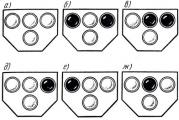What does the readln operator mean in pascal. Subject: Input - Output
Read (procedure)
For typed files, reads the file component into a variable.
- For text files, reads one or more values
into one or more variables
Announcement
Typed files
Procedure Read (F, V1 [, V2, ..., Vn]);
Text files
Procedure Read ([Var F: Text;] V1 [, V2, ..., Vn]);
Mode
Windows, Real, Protected
Remarks
For string variables:
Read reads all characters up to (but not including) the next end-of-line marker or until Eof(F) will become True. Read does not move to the next line after reading. If the resulting string is longer than the maximum length of the string variable, then it is truncated. After the first Read, each subsequent Read calls will see the end-of-line marker and return a zero-length string.
Use multiple calls to ReadLn to read multiple string values.
When the option is enabled Extended syntax, the Read procedure can read null-terminated strings to null-based character arrays.
For variables like Integer or Real:
Read will skip any spaces, tabs, or end-of-line markers preceding a numeric line. If the numeric string does not match the expected format, an I / O error occurs, otherwise the variable is assigned the resulting value. The next Read will begin with a space, tab, or end-of-line marker that terminated the numeric string.
see also
Example
uses Crt, Dos;
var
F: Text;
Ch: Char;
begin
(Get the file name from command line }
Assign (F, ParamStr (1));
Reset (F);
while not EOF (F) do
begin
Read (F, Ch);
Write (Ch); (We display the contents of the file on the screen)
end;
end.
I think many will be interested in it)))
Read and readln statements
The read instruction is intended for entering the values of variables (initial data) from the keyboard. In general, the instruction looks like this:
read (Var1, Var2, ... VarN)
where variables is the name of a variable whose value must be entered from the keyboard during program execution.
Here are examples of writing a read statement:
read (a); read (Cena, Kol);
When the read statement is executed, the following happens:
1. The program pauses its work and waits until the required data is typed on the keyboard and the key is pressed
2 http://tissot.ua/ buy a watch buy a watch kiev. ... After pressing the key
For example, as a result of executing the instruction
read (Temperat);
and typing line 21, the value of the variable Temperat will be the number 21.
One read statement allows you to get the values of several variables. In this case, the entered numbers must be typed on one line and separated by spaces. For example, if the type of variables a, b, and c is real, then as a result of the execution of the instruction read (a, b, c); and keyboard input string:
4.5
23 0.17
variables will have the following values:
a = 4.5; b = 23.0; c = 0.17.
If the line contains more numbers than the variables specified in the read instruction, the rest of the line will be processed by the following instruction read http://crystal.lviv.ua crystal crystal. ... https://mainvisa.com.ua photo invitation to Ukraine for foreign citizens. ... For example, as a result of executing the instructions
read (A, B); read (C);
and keyboard input string
10
25 18
variables will receive the following values: A = 10, B = 25. Read instruction (C); will assign to the variable with the value 18.
The readln instruction differs from the read instruction in that after selecting the next number from the line entered from the keyboard and assigning it to the last variable from the list of the readin instruction, the rest of the line is lost, and the next read or readin instruction will require new input.
For example, as a result of executing the instruction
readin (A, B); read (C);
and typing the string
10
25 18
the variables will receive the following values: A = 10, B = 25. After that, the program will wait for a new number to be entered in order to assign it to the variable c.
Each read or readin instruction should be preceded by a write instruction to tell the user what data the program expects from him. For example, a fragment of the program for calculating the cost of a purchase might look like:
writeln ("Enter the initial data.");
Write ("Product price:");
Readln (Сenа);
write ("Quantity in the batch:");
Readln (Kol);
write ("Discount:");
readln (Skidka);
If the type of data entered from the keyboard does not match or cannot be converted to the type of variables whose names are specified in the read (readin) instruction, the program crashes (instructions following read are not executed), and a message is displayed on the screen about the error.
The read instruction is intended for entering the values of variables (initial data) from the keyboard. In general, the instruction looks like this:
read (variable !, variable2, ... variable
Here are examples of writing a read statement:
Read (a); read (Cena, Kol);
When the read statement is executed, the following happens:
1. The program pauses its work and waits until the required data is typed on the keyboard and the key is pressed
2. After pressing the key
For example, as a result of executing the instruction
Read (Tempérât);
and typing line 21, the value of Tempérât is 21.
One read statement allows you to get the values of several variables. In this case, the entered numbers must be typed on one line and separated by spaces. For example, if the type of variables a, b, and c is real, then as a result of executing the read (a, b, c); and keyboard input string:
4.5 23 0.17
the variables will have the following values: a = 4.5; b = 23, o; c = 0.17.
If the line contains more numbers than the variables specified in the read statement, then the rest of the line will be processed by the next read statement. For example, as a result of executing the instructions:
Read (a, B); read (C);
and keyboard input string
10 25 18
variables will receive the following values: a = 10, b = 25. Read instruction (C); will assign to the variable with the value 18.
The readln instruction differs from the read instruction in that after selecting the next number from the line entered from the keyboard and assigning it to the last variable from the list of the readln instruction, the rest of the line is lost, and the next read or readln instruction will require new input.
For example, as a result of executing the instruction:
Readln (a, B); read (C);
and typing the string
10 25 18
the variables will receive the following values: a = 10, b = 25. After that, the program will wait for a new number to be entered in order to assign it to the variable c.
Each read or readln instruction should be preceded by a write instruction to tell the user what data the program expects from him. For example, a fragment of the program for calculating the cost of a purchase may look like:
Writeln ("Enter the original data."); write ("Product price:"); readln (Sepa); write ("Quantity in the batch:"); readln (Kol); write ("Discount:"); readln (Skidka);
If the type of data entered from the keyboard does not match or cannot be converted to the type of variables whose names are specified in the read (readln) statement, the program crashes (instructions following read are not executed), and a message is displayed on the screen about error.
The Readln routine is used for more than just screen delay. Its main task is to enter data from the keyboard. In this article, we will learn how to enter numbers from the keyboard, and then display them on the screen. To do this, we will need to get acquainted with the section for describing Var variables, as well as with one of the data types used in Pascal.
Program number3; uses crt; var n: integer; begin clrscr; write (‘Enter a number from the keyboard:’); readln (n); writeln (‘You entered a number’, n); readln end.
In line # 3, we write the service word Var. It is used to declare variables. Variables are different values, numbers, or words that can change during program execution. When we enter numbers or letters from the keyboard, they are written into variables. After the word Var, we indicate the variable identifier (that is, its name, which we come up with ourselves), separated by a space. Variables are not service words, the programmer sets them himself. In this case, we have set one variable "n" and in the future we will use only this variable. After writing the variable, the data type is indicated with a colon. There are several types of data. One of them is Integer. It makes it clear to the program that our variable "n" can only be an integer ranging from -32768 to 32767. Usage different types data depends on the specific needs of the programmer when writing the program. The most important thing at this stage is to understand that if you are going to use some number in your program, then you need to specify a variable (in our case "n") and a data type (in our case Integer) for it.
In line # 7, we write a statement for entering data from the keyboard Readln. This statement calls the built-in data entry routine and at this point the program stops and starts waiting for data entry. We have already used this operator for screen delay. In this program, after the Readln statement, our variable "n" is indicated in parentheses. The number that we will enter from the keyboard will be written to this variable. Accordingly, this number must correspond to the parameters of the variable, i.e. must be an integer in the range -32768 to 32767. After the program reaches the 7th line, it will display the message "Enter a number from the keyboard:" and will wait. At this stage, we must enter some number and press Enter.
Line number 8. This is where we write an output statement to the Writeln screen. It will display the message "You have entered a number", and will also display the value of our variable "n" (that is, the value that we enter from the keyboard). Note that in line # 8 we put a comma before the variable "n", and the variable itself is not enclosed in apostrophes.
Now let's type the program in Pascal.
Run (Ctrl + F9). We type a number, for example, 5 and press Enter.
author Alexander asked a question in the section Other languages and technologies
Why does Pascal have read and readln, if read also translates a line, although in theory it shouldn't? and got the best answer
Answer from Skipy _ [guru]
readln - takes a value from the input buffer into a parameter, flushes the entire keyboard input buffer
and read - takes the value from the input buffer into the parameter and does not clear it into the buffer, but leaves the value !! !
automatic line feed when typing - everywhere
i.e. readln is safe input
read- unsafe input
example:
var
a, b: integer;
begin
read (a); (user entered: 4, 5 a = 4)
(in the input buffer the number 5!!}
read (b); (here he entered a number: 6, but b = 5)
(the number 6 remains in the input buffer!!}
---
readln (a); (user entered: 4, 5; a = 4)
(the input buffer is clear!!}
readln (a); (user entered number 6 and b = 6)
(the input buffer is clear!!}
readln (b);
end.
On the contrary, there is no automatic detection of the type of the input value, everything is determined by the conventions in the format specifier.
Answer from Yoali-Mali[guru]
It can be explained in a simpler way, without any special problems:
When the read procedure is executed, the value of the next data is read from the same line, and when the readln procedure is executed, the value of the next data is read from a new line.
Therefore, the operator Readln (b1, b2, ... bn); provides data entry into the BAR.
After entering each variable b1, b2, ..bn, the cursor moves to the beginning of a new line.
Read operator (b1, b2, ... bn); provides data entry into the LINE
Answer from VT-107 FIT[guru]
Here something Dmitry went wrong, but not true. And about a completely cleaned and uncleaned buffer and about safety. Sali also did not answer correctly. There are no columns and lines, completely different rules.
First, these procedures do not only work with console input, so two functions are needed.
procedure Read (F, V1 [, V2, ... Vn]);
reads all V1..Vn from the stream (exactly n parameters), all read data will be deleted. Everything that will happen after this data will remain unchanged.
Reading a line will read everything up to a newline or end of file. Subsequent calls to read will return an empty string. And the newline character will not be removed from the stream.
If you read a char, then depending on the settings, the newline character can be read as char (26)
When reading numbers, all spaces, tabs, line breaks are skipped. And the next reading will start with the character following the number read. Again, unnecessary characters can be skipped.
procedure ReadLn ([var F: Text;] V1 [, V2, ..Vn]);
reads from stream V1, Vn (that is, it works like read) and then skips all characters up to and including the newline. All characters after a line break will remain unchanged.
Go to new line is carried out because you press Enter in the console.
About safety far-fetched. These are functions with different purposes. Any incorrect use of them is not safe, any correct and correspondingly safe.




